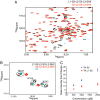Conserved interdomain linker promotes phase separation of the multivalent adaptor protein Nck
- PMID: 26553976
- PMCID: PMC4664304
- DOI: 10.1073/pnas.1508778112
Conserved interdomain linker promotes phase separation of the multivalent adaptor protein Nck
Abstract
The organization of membranes, the cytosol, and the nucleus of eukaryotic cells can be controlled through phase separation of lipids, proteins, and nucleic acids. Collective interactions of multivalent molecules mediated by modular binding domains can induce gelation and phase separation in several cytosolic and membrane-associated systems. The adaptor protein Nck has three SRC-homology 3 (SH3) domains that bind multiple proline-rich segments in the actin regulatory protein neuronal Wiskott-Aldrich syndrome protein (N-WASP) and an SH2 domain that binds to multiple phosphotyrosine sites in the adhesion protein nephrin, leading to phase separation. Here, we show that the 50-residue linker between the first two SH3 domains of Nck enhances phase separation of Nck/N-WASP/nephrin assemblies. Two linear motifs within this element, as well as its overall positively charged character, are important for this effect. The linker increases the driving force for self-assembly of Nck, likely through weak interactions with the second SH3 domain, and this effect appears to promote phase separation. The linker sequence is highly conserved, suggesting that the sequence determinants of the driving forces for phase separation may be generally important to Nck functions. Our studies demonstrate that linker regions between modular domains can contribute to the driving forces for self-assembly and phase separation of multivalent proteins.
Keywords: adaptor proteins; interdomain linker; intrinsically disordered; multivalency; phase separation.
Conflict of interest statement
The authors declare no conflict of interest.
Figures






References
-
- Spector DL. SnapShot: Cellular bodies. Cell. 2006;127(5):1071. - PubMed
-
- Hyman AA, Simons K. Cell biology. Beyond oil and water--phase transitions in cells. Science. 2012;337(6098):1047–1049. - PubMed
-
- Brangwynne CP, et al. Germline P granules are liquid droplets that localize by controlled dissolution/condensation. Science. 2009;324(5935):1729–1732. - PubMed
Publication types
MeSH terms
Substances
Grants and funding
LinkOut - more resources
Full Text Sources
Other Literature Sources
Molecular Biology Databases
Miscellaneous

